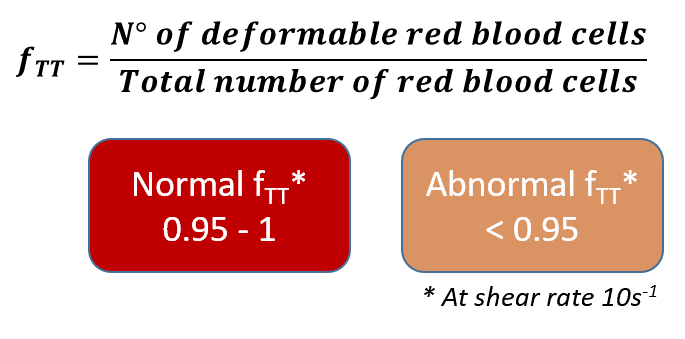Our solution
The Dynared system combines millifluidics, advanced video microscopy, and AI-based image analysis (machine learning)
ICOVELL’s innovation lies in using the motion of red blood cells subjected to shear stress within a flow to determine their individual deformability.
For a given shear stress, there is a critical deformability threshold above which a red blood cell behaves like a fluid drop — exhibiting “Tank-Treading (TT)” motion.
Below this threshold, it behaves like a solid — showing “Tumbling” or non-TT motion.
TT red blood cells are deformable, while non-TT cells are non-deformable.
1-Videomicroscopy
Observation of red blood cells in a flow chamber.
2-AI Classification

Top (image sequence) and side (scheme) views of two red blood cells showing tank-treading motion (top) and tumbling motion (bottom).
3-fTT Biomarker

Fraction of deformable red blood cells within a heterogeneous population (single drop of blood).
Dynared: A major breakthrough based on four key technological innovations

A new mechanical marker — fTT — for red blood cell deformability
Sensitive to red blood cell viscosity and deformation dynamics.
Relevant for heterogeneous red blood cell populations, characteristic of many diseases.

An advanced measurement method
A patented combination of video microscopy and AI-based image analysis makes it possible to observe the individual motion of each red blood cell, providing direct access to its individual deformability.

An integrated and autonomous measurement device
Requiring only a single drop of blood, usable at the patient’s bedside, and operable by non-technical staff.

An intelligent application
Combining data from our biomarker with conventional clinical parameters to provide clinicians with fast and effective decision support.
Our scientific publications
- A novel red blood cell deformability biomarker is associated with hemolysis and vaso-occlusive crises in sickle cell disease. M. Sahun, E. Bernit, S. Atwell, A. Hornung, A.M. Charrier, I. Agouti, N. Bonello-Palot, M. Cerino, E. Helfer, C. Badens, A. Viallat, Scientific Reports 15, 15864 (2025). https//doi.org/10.1038/s41598-025-00152-w
- Classification of red cell dynamics with convolutional and recurrent neural networks : a sickle cell disease case study. Darrin, M., Samudre, A., Sahun, M., Atwell, S., Badens, C., Charrier, A., … & Giffard-Roisin, S. Scientific Reports, 13(1), 745 (2023). https://doi.org/10.1038/s41598-023-27718-w
- Dynamics of individual red blood cells under shear flow: a way to discriminate deformability alterations. Atwell, S., Badens, C., Charrier, A., Helfer, E., & Viallat, A. Frontiers in Physiology, 12, 2406 (2022). https ://doi.org/10.3389%2Ffphys.2021.775584
- A simple model to understand the effect of membrane shear elasticity and stress-free shape on the motion of red blood cells in shear flow. Dupire J., Abkarian M., Viallat A. Soft matter 11, 8372-8382 (2015). https://doi.org/10.1039/C5SM01407G
- Red blood cell: from its mechanics to its motion in shear flow. A. Viallat, M. Abkarian, Int. Jnl. Lab. Hem. 36, 237–243 (2014). https://doi.org/10.1111/ijlh.12233
- Full dynamics of a red blood cell in shear flow. Dupire J., Socol M., Viallat A. Proc. Nat. Acad. Sci. 109, 20808-20813 (2012). https://www.pnas.org/doi/full/10.1073/pnas.1210236109
- Patent: Méthode et dispositif de détermination de la déformabilité de globule rouge. Annie Viallat, Emmanuèle Helfer, Catherine Badens, Scott Atwell et Anne Charrier. EP3821241 B1, US20220341919 A1


